Today I have a guest post from someone who I admire tremendously, and who really knows her stuff—between the ears.
She’s a peak performance mindset coach (she’s on the way to being my new Tony. 🙂 )
And how much of what we do in life (and triathlon) is about our mental state!?
(Um, the answer is SO much of it!).
I hope you enjoy this post from the amazing Deb Cheslow.
I’d like to thank Meredith for turning over the reins of the blog to me today. I know what a big deal this is, and I’m grateful for the opportunity to share with you.
In the interest of full disclosure, the first thing you should know about me is that I am NOT a triathlete, nor do I have any desire to be a triathlete.
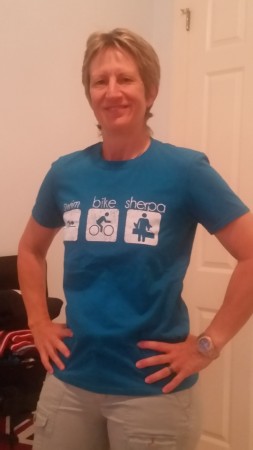 I do, however, live with a brand new Ironman, and I’ve been told that I am one of the best Sherpas around, so I have an interesting perspective on the sport from the other side of the finish line, while having full appreciation for the level of commitment that is required to be successful in your sport.
I do, however, live with a brand new Ironman, and I’ve been told that I am one of the best Sherpas around, so I have an interesting perspective on the sport from the other side of the finish line, while having full appreciation for the level of commitment that is required to be successful in your sport.
So, why am I here on the blog? Well, I’m a coach – not a triathlon coach or an athletic coach, but a peak performance mindset coach. I work with individuals, businesses, organizations, and teams all over the country to help them get past the noise inside their own heads that limits their results.
I’ve studied triathletes for years and I’ve worked with many amateur age-group athletes in my practice that had HUGE goals for what they wanted to accomplish in the triathlon world. They came to me frustrated. They worked hard – 5, 6, even 7 days per week – and trained their bodies in a way that should have – all things being equal – led to success, and yet they kept coming up short – elusive PRs, performing well below expectations, DNFs in races, injuries, and so on. How could such diligent work fail to pay off time after time, race after race?
Well, what they didn’t realize was that they were neglecting an entire facet of their training.
Although they trained their bodies diligently, they had not adequately trained their MINDS! They didn’t own their inner triathlete, their inner BADASS (because let’s be clear, what you folks do out there on the course IS badass)! Noteworthy accomplishments were quickly brushed aside as a matter of “luck” or a “fluke,” and God-forbid they actually claim their sport. Of all the people I’ve coached, not one of them self-identified as a “triathlete” in the beginning. Even my partner, Angie Flynn, was months into her training for Ironman Florida before she really and truly identified herself as a triathlete and claimed her inner badass. Then there was no stopping her.
Mental toughness training is a critical aspect for athletes to address in their overall training regimen, and that involves realizing how much you are actually capable of (way more than you may think) and viewing yourself as a strong, capable, badass triathlete. If you don’t believe this you are handicapping yourself just as surely as if you showed up to race an Ironman without ever having swam a single stroke.
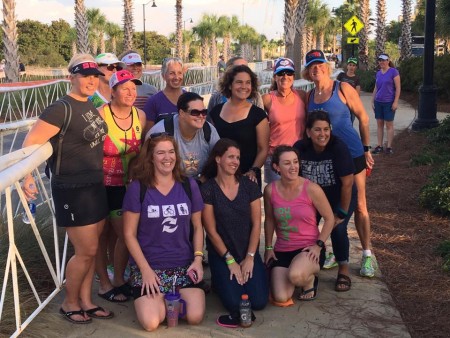

So, let me be clear:
You will never reach your true potential and achieve the peak performance you are capable of until you start taking yourself seriously in your sport – until you own it.
And a funny thing happens when you do that… performance barriers start to topple like dominos. Speed and endurance begin to increase almost overnight without any other cause than you suddenly BELIEVE it’s possible.
Now, does that mean you’re going to go from back of the pack to winning overnight? Well, I guess that depends on how you define “winning,” doesn’t it? Showing up for a training session with intention and being present during the entire workout, rather than just haphazardly getting through it so you can check a box is a “win”… Setting a PR when you have failed to beat that elusive time over and over again is a “win”… Finishing a race that you DNFed last year is a “win” … Finishing with a smile on your face when you normally puke at the line is a “win,” right? The thoughts you think about yourself (your mindset) place an artificial ceiling on your performance, and once you change your mindset, performance will naturally change. It bears out over and over again.
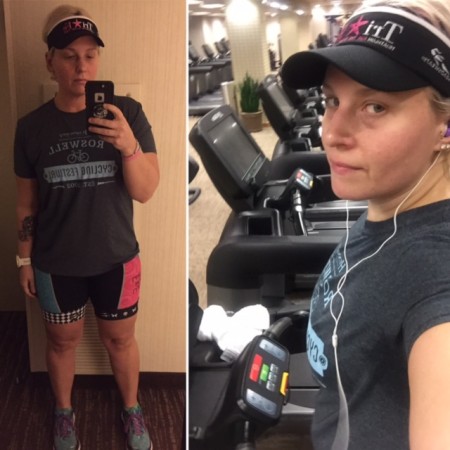

How do we do that? Ah, that’s the question, isn’t it?
Here are my 6 tips for owning your inner badass:
1) Tell the Voice in Your Head to Take a Hike.
You know the voice, right? The one that tells you it’s okay to walk when you really could run farther… the one that tells you you’re not good enough… the one that asks you who you think you are to be calling yourself a triathlete… I call that little voice “logic,” and its primary job is to keep us safe and stuck right where we are by talking us out of pursuing big dreams that force us out of our comfort zone.
If you ever listen to one of my talks or read one of my books, you are guaranteed to hear me say, “Logic is the key to failure.” What do I mean by that? Well, logic is the accumulation of our past experience and our present knowledge. It’s everything we’ve done and everything we know. So, how can we possibly rely on it to take us some place we’ve never been before… to do something we’ve never done before? We can’t. In its effort to keep you safe, your logic will find your most sensitive buzz point – the thing that is most likely to get you to cave in and walk away from your dream, and it knows all your deepest, darkest secrets and fears – because it IS you!
Logic LIES! So, don’t listen to it. Tell the voice in your head to take a hike!
2) Success Leaves Clues.
When you boil it all down, there are really very few completely original ideas out there, so chances are really good that if you want to accomplish something, someone, somewhere has already done it. This helps us in a couple of ways. First, if someone has already done something we want to do, then we have to acknowledge that it IS possible from the get go, right? Knowing that builds our belief that we can do it too.
Second, if something has already been done then there MUST be a roadmap for you to follow – a recipe for success, if you will. That roadmap shortens the learning curve. Find out what people who are consistently successful (or consistently improving) in triathlon do, and then start incorporating more of those things into your own life. I am continually impressed by how generous triathletes are with their time and knowledge. All you have to do is ask them for their advice. The Swim Bike Mom blog contains a treasure trove of knowledge, “been there, done that” experience, and advice, as well as a step-by-step roadmap of Meredith’s FOUR Ironman races, plus all her other race experience. If she can do it, you can do it, and if you ask, she’ll tell you exactly how!
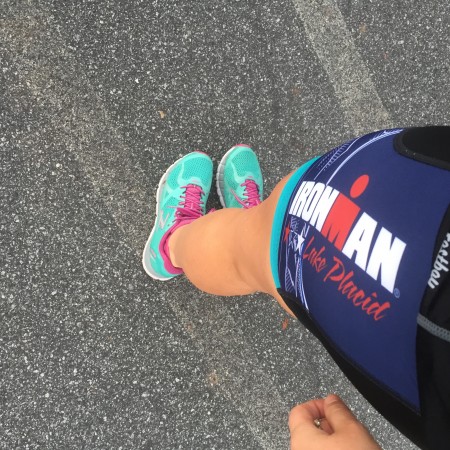

3) Act As If.
For many people, owning their inner badass is not a simple matter. They may see it as unseemly or bragging to proclaim themselves a “badass triathlete.” Please don’t misunderstand me; I am not suggesting that you start posting every workout on social media or stop everyone you meet in the aisles at the supermarket and tell them, “I’m training for a triathlon, you know.” Not at all. This is more inner work than outer work. You don’t ever have to say anything to anyone at all, except yourself. Silence that inner voice of logic. Change your self-talk to that of a badass triathlete – if you FEEL like one on the inside, you will perform more like one on the outside. So, act as if… “fake it, til you make it!”


4) See It.
Visualization is a tool I have all my clients use when they are pursuing a big goal. I have them see and feel their life as if their goal was already accomplished. You can do the same thing! Visualize your perfect race, see your smooth entry into the water, feel your confidence build during the swim, see the smooth, swift transition to the bike, see yourself passing other racers… Do this for the entire race, and do it every day – before bed is a great time because you will likely fall asleep somewhere in the middle of your visualization, which gives your subconscious mind all night to work on your race strategy. Practice perfectly in your mind. In the real world make sure you learn how to change a flat and practice doing so; practice eating and drinking on the bike; learn how to put your chain back on, etc. during training and develop a race day strategy with plenty of contingencies built in, but when it comes to visualizing only focus your attention on your PERFECT race.
Angie did this while training for Ironman Florida. Every day she visualized her perfect race. She would do it before bed each night. She would do it during trainer rides and during long runs. By the time race day rolled around she still wasn’t sure HOW the whole Ironman thing was supposed to come together, but she had raced the course hundreds of times in her mind – perfectly. And, in the end, with the exception of a little extra wind, her race unfolded pretty much exactly as she visualized it.
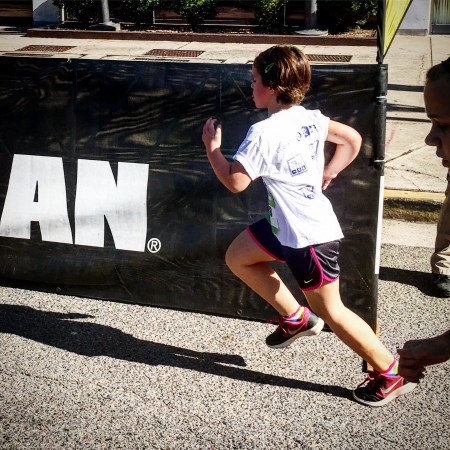

5) Put It In A Box.
Top performers (badasses) in any field are very good at compartmentalizing (what I call “putting it in a box”). They focus on the issue at hand and forget about everything else in their life and then they move on to the next thing. I use the “put it in a box” technique all the time in my coaching practice. When I sit down with a client, all my attention has to be on them; how can I help them with their problems if I am still focusing on my own garbage? So, before I walk in, I close my eyes and picture myself taking a big box and putting all my mental “stuff” inside – the argument with my daughter, the lecture I had to give to my son, the muscles that are aching from yesterday’s weightlifting workout, etc. I imagine putting the lid on the box, and then shoving it up on a shelf. Then, I take a deep breath and head into my session excited that I am going to help my client make a break through that day.
Now here’s the thing: I know I can pull that box down any time and unpack all those problems, but oftentimes I don’t even bother. But even when I do have to unpack the box and deal with the problems, somehow they never seem as bad as they did when they went in the box, and many of them magically resolve themselves without me having to do anything at all. It’s amazing how a little bit of time seems to solve so many things.
Putting it in a box works before a big training session, before a race, during a race (when everything hurts and you want to quit), and it can even work when dealing with your family, your job, etc.


6) Relax.
One thing I have learned over the years by working with people of all different personalities and backgrounds is that force negates everything. Badass triathletes are made over time – it’s a mindset that develops with patience and persistence, and although it can be encouraged, it can’t be forced. So, show up, do the work, use these tips and tools, and then relax, because whether you see it yet or not, you ARE a badass triathlete. You are doing amazing things with your body every day that most people will never even dare to dream. Whether you win your race or come in dead last, you have my utmost respect, and I salute you all!
[SBM Note: YES TO ALL OF THIS!!]


Deb Cheslow is America’s Achievement Expert. She is a coach, trainer, speaker, and international best-selling author in the field of peak performance and leadership and has worked with individuals and companies across the United States sharing systems and tools to take their results to the next level.
Deb offers a free video series to empower athletes in their pursuit of “better” at www.DebCheslow.com/innerbadass.
Deb’s 6th book, Unrealogical – Real People, Remarkable Stories of Transformation, is scheduled for publication by Hay House Publishing/Balboa Press in Spring, 2017. Learn more about Deb, her company – Cheslow Achievement Group – and her programs and live events at www.Deb Cheslow.com.
